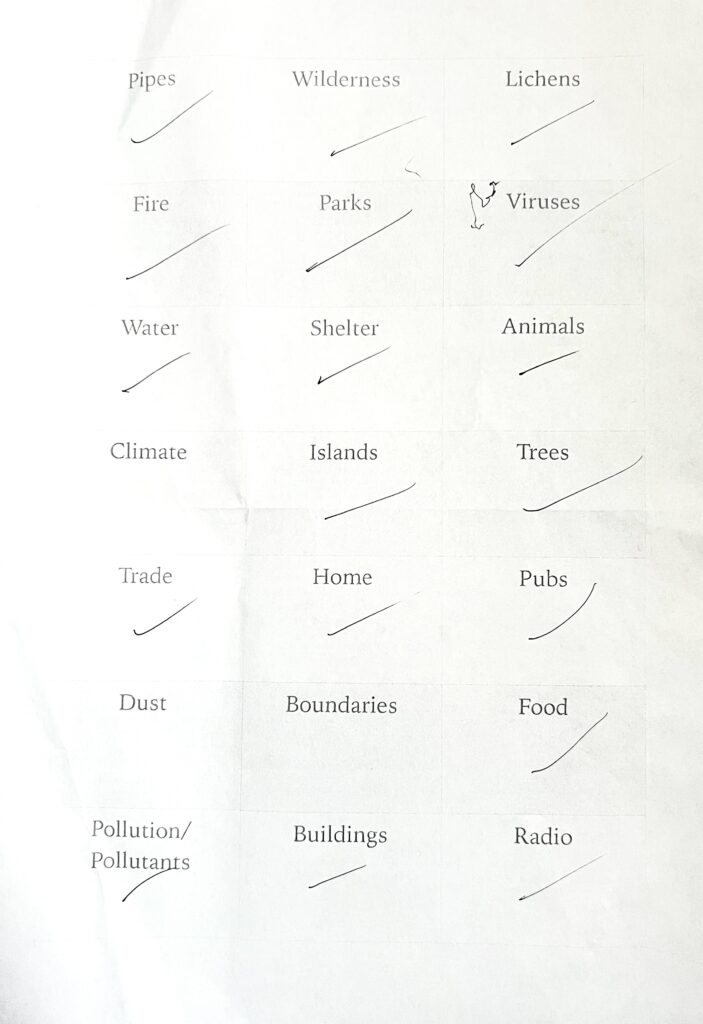In the workshop this week, I was tasked to record elements from urban environments & nature in general. During a brief 10-minute walk near the campus, I aimed to identify as many unique features as possible that could vaguely relate to natural elements. The exercise revealed how dominated our surroundings are by manmade structures & objects. Interestingly, I found myself struggling to locate simple elements like water or fire, highlighting how such important aspects of nature are obscured in urban spaces. Instead, it was much easier to encounter constructed elements like buildings, trade, radios, & pipes. I particularly enjoyed thinking creatively about how to represent some of these elements – such as recording a pillar covered in posters with foliage growing from the top as an example of the contrast human activity & the natural elements.


Sketches from the workshop (2024), Natalie Foster.
This workshop experience reinforced the way I now view my surroundings, especially in light of my research into the biophilia hypothesis as part of my MA Illustration project. I plan to incorporate this concept into a travel illustration journal that will emphasize the human connection to nature. The biophilia hypothesis, introduced by Edward O. Wilson in 1984, proposes that humans have an inherent tendency to seek connections with the natural world. Our evolutionary history has ingrained within us a deep emotional bond with landscapes, animals, and natural settings, & I find this concept particularly resonant with the way I interpret and reflect on design & the environment. It is speculated that the divergence between nature & humans began when technological developments became more prevalent in the 19th/20th century. Enclosed/sterile spaces, cars & workplaces are where most people spent their time, sheltered away from the elements of nature.
to nature. The biophilia hypothesis, introduced by Edward O. Wilson in 1984, proposes that humans have an inherent tendency to seek connections with the natural world. Our evolutionary history has ingrained within us a deep emotional bond with landscapes, animals, and natural settings, & I find this concept particularly resonant with the way I interpret and reflect on design & the environment. It is speculated that the divergence between nature & humans began when technological developments became more prevalent in the 19th/20th century. Enclosed/sterile spaces, cars & workplaces are where most people spent their time, sheltered away from the elements of nature.
(Pictured right) Grow Urban, Edinburgh, (2023), Adi Forgang.
Grow urban is both a plant & coffee shop which I walk past every day – evidencing the biophilia hypothesis as they bring the natural elements inside.
This change in environment became normal, yet it impacted many people’s mental health – this lack of interaction with the natural world created a decrease in appreciation for life forms that support human survival, resulting in more species extinction & less consideration for nature conservation. This hypothesis explains why human connection to nature is important & why people tend to feel rejuvenated after spending time outdoors, why we are drawn to natural beauty & why natural elements are often incorporated into urban spaces. What I
find particularly striking is how, after generations of industrialization & urbanization, society has begun to recognize the need to reintroduce nature into urban spaces. This reflects a growing understanding of the psychological and emotional benefits that come from reconnecting with natural elements.
(Pictured left) Sketch of a houseplant (2024), Natalie Foster.

Growing up with a focus on sustainable design education, I have always been conscious of the relationship
between manmade environments & the natural world. The insights from this workshop & my broader studies continually shape how I navigate industrialized spaces, reminding me to seek natural elements even in highly constructed environments – it’s something I’ve always loved about some pieces of designs. The biophilia hypothesis resonates with my own belief in the power of nature to restore & inspire, both in
my creative work & in the way I engage with the world around me.
____
Rogers, K. (2019). Biophilia hypothesis. In: Encyclopædia Britannica. [online] Available at: https://www.britannica.com/science/biophilia-hypothesis.



